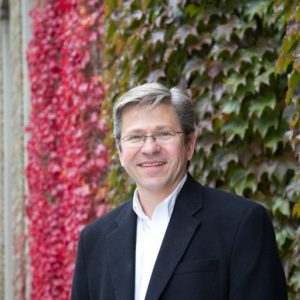H. Floyd Davis has been at Cornell since 1994, and is currently Professor of Chemistry. Davis and his research group carry out experimental studies of the dynamics of elementary reactions using laser and molecular beam methods. Areas of interest include atmospheric halogen oxide chemistry, the chemistry of organic free radicals and carbenes relevant to combustion, atmospheric chemistry, and organic chemistry, and the reactions of neutral transition metal atoms and clusters with hydrocarbon molecules. The key experimental tool employed in our laboratory is mass spectrometry, primarily employing “soft” photoionization detection of neutral molecules by pulsed vacuum ultraviolet radiation generated by nonlinear frequency conversion using tabletop light sources.
 Davis completed his undergraduate degree at the University of Waterloo (Canada) in 1986, where he was a Coop student in the Applied Chemistry program. During his undergraduate years, he worked for four semesters (1983-1985) at the Notre Dame Radiation Laboratory with Prof. Richard Fessenden and Dr. P.K. Das, and two semesters (1982-1983)at Nalco Chemical Company (Burlington, Ontario). During his senior year at Waterloo (1985-1986) he worked with Professor J.W. Hepburn on the photodissociation dynamics of small molecules using coherent VUV for product detection.
Davis completed his undergraduate degree at the University of Waterloo (Canada) in 1986, where he was a Coop student in the Applied Chemistry program. During his undergraduate years, he worked for four semesters (1983-1985) at the Notre Dame Radiation Laboratory with Prof. Richard Fessenden and Dr. P.K. Das, and two semesters (1982-1983)at Nalco Chemical Company (Burlington, Ontario). During his senior year at Waterloo (1985-1986) he worked with Professor J.W. Hepburn on the photodissociation dynamics of small molecules using coherent VUV for product detection.
In 1986, Davis began his Ph.D. in Chemistry at the University of California, Berkeley in the research group of Prof. Yuan T. Lee (1986 Nobel Prize in Chemistry) as an NSERC 1967 Science and Engineering Predoctoral Fellow. His Ph.D. research focused on bimolecular reactions of alkali and alkaline earth atoms with oxidants, and the photochemistry of free radicals relevant to atmospheric chemistry. In collaboration with Prof. Harold S. Johnston, Davis carried out the first studies of the visible photodissociation of NO3 radicals under collision-free conditions. He also studied the photochemistry of OClO and was the first to map out the branching ratios between the Cl + O2 and ClO + O channels, a topic which up to that date was highly controversial. In 1992, Davis joined the research group of Prof. Curt Wittig at the University of Southern California as a Postdoctoral Research Associate, where he carried out time resolved measurements of unimolecular dissociation of small free radicals, including NO3.
